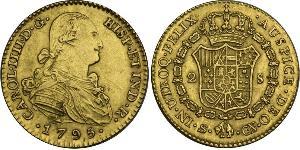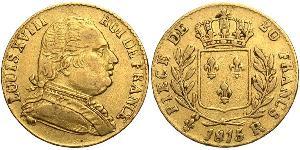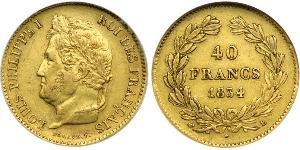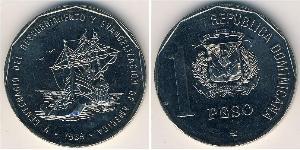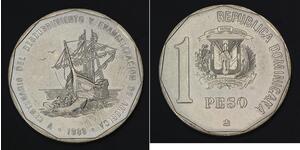2 Louis d'or
1786-H, France, Louis XVI. Scarce Gold 2 Louis d'or Coin. (15.29gm!) NGC MS-62!
Mint year: 1786
Mintage: 42,518 pcs.
Mint Place: La Rochelle (H)
Denomination: Double Gold Louis (2 Louis d'or)
References: Friedberg 475, KM-592.6 ($3000 in MS!). RR!
Condition: Certified and graded by NGC as MS-62! - Population 5/2!
Material: Gold (.917)
Diameter:
28mm
Weight: 15.29gm
Obverse: Bare-headed and draped bust of Louis XV left. Privy mark (achor) below.
Comment: Designer`s signature (DU VIV. for Du Vivier) inside bust truncation!
Legend: LUD . XVI . D . G . FR . ET NAV . REX
Translated: "Louis XVI, by the grace of God king of France and of Navarre."
Reverse: Crown above shields of France and Navarre. Mint initial (H) of the La Rochelle mint below.
Legend: CHRS . REGN . VINC . IMPER (privy mark: castle) I786
Translated: "Christ reigns, defeats and commands!"
La Rochelle (Poitevin-Saintongeais: La Rochéle; Occitan: La Rochèla) is a city on the west coast of France and a seaport on the Bay of Biscay, a part of the Atlantic Ocean. It is the capital of the Charente-Maritime department. With 75,735 inhabitants in 2017, La Rochelle is the most populated commune in the department and ranks fifth in the New Aquitaine region after Bordeaux, the regional capital, Limoges, Poitiers and Pau. Its inhabitants are called "les Rochelaises" and "les Rochelais".
Situated on the edge of the Atlantic Ocean the city is connected to the Île de Ré by a 2.9-kilometre-long (1+3⁄4-mile) bridge completed on 19 May 1988. Since the Middle Ages the harbour has opened onto a protected strait, the Pertuis d'Antioche and is regarded as a "Door océane" or gateway to the ocean because of the presence of its three ports (fishing, trade and yachting). The city has a strong commercial tradition, having an active port from very early on in its history. La Rochelle underwent sustained development in the middle ages, and has maintained a standing in modern times because of its port, La Pallice, the only deep water port of the French Atlantic coast; it is ranked as the sixth most important port of France.
The city traces its origins to the Gallo-Roman period, attested by the remains of important salt marshes and villas. The Dukes of Aquitaine granted it a charter as a free port in 1130. With the opening of the English market following the second marriage of Eleanor of Aquitaine in 1152, the presence of the Knights Templar and the Knights of Saint John of Jerusalem quickly made this small town the largest port on the Atlantic.
To this day, the city still possesses a rich historical fabric, including the Saint-Nicholas tower, and an urban heritage. The capital of Aunis, it has become the most important coastal city between the Loire and Gironde estuaries. La Rochelle's urban activities are many in number and strongly differentiated, being a city with port and industrial functions that are still important, but also including a predominantly administrative and tertiary sector that is reinforced by the university and a rapidly developing tourism industry. In the early 21st century, the city has consistently been ranked among France's most liveable cities.
Louis XVI or Louis-Auguste de France (Versailles, 23 August 1754 – Paris, 21 January 1793) ruled as King of France and of Navarre from 1774 until 1791, and then as King of the French from 1791 to 1793. Suspended and arrested during the Insurrection of 10 August, he was tried by the National Convention, found guilty of treason, and executed by guillotine on 21 January 1793. He was the only king of France to be executed.
Although Louis was beloved at first, his indecisiveness and conservatism led some elements of the people of France to eventually view him as a symbol of the perceived tyranny of the Ancien Régime. After the abolition of the monarchy in 1793, the new republican government gave him the surname Capet, a reference to the nickname of Hugh Capet, founder of the Capetian dynasty, which the revolutionaries wrongly interpreted as a family name. He was also informally nicknamed Louis le Dernier (Louis the Last), a derisive use of the traditional nicknaming of French kings. Today, historians and French people in general have a more nuanced view of Louis XVI, who is seen as an honest man with good intentions, but who was probably unfit for the herculean task of reforming the monarchy, and who was used as a scapegoat by the revolutionaries.

|
Publicado por:
anonymous 2024-03-12 |
|
||
|
||
|
||
|
||
|
||
1 Peso República Dominicana Níquel/Cobre
grupo tiene 3 monedas / 3 precios
⇑

-600-300-EvgsHgTyKBsAAAGO3P8HkTTg.jpg)

-300-150-4cMKX9ISJToAAAFYBRa668ND.jpg)
 Deutsch
Deutsch Русский
Русский Українська
Українська English
English Italiano
Italiano Français
Français Español
Español 汉语
汉语



